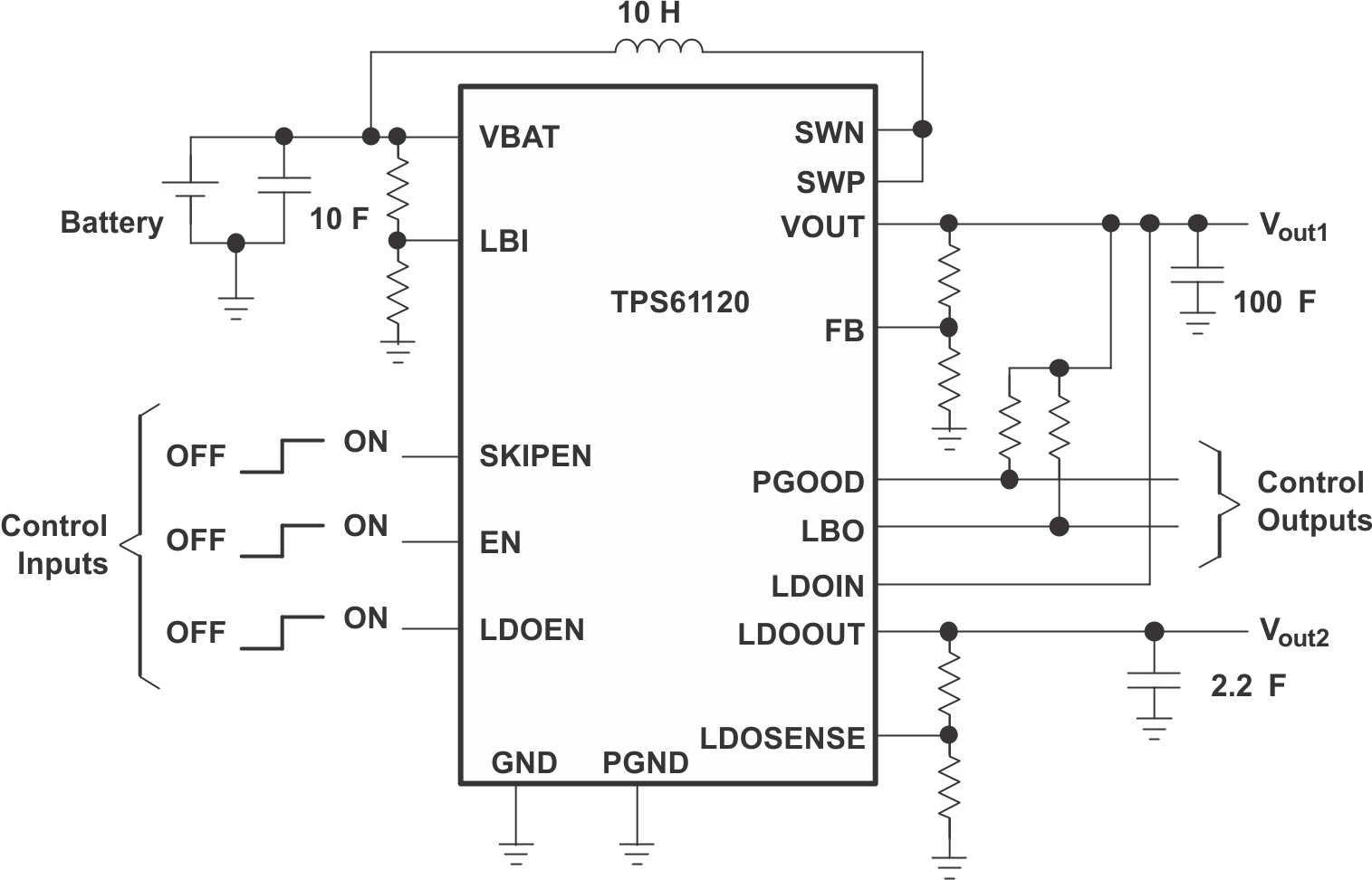SLVS427D JUNE 2002 – May 2015 TPS61120 , TPS61121 , TPS61122
PRODUCTION DATA.
- 1 Features
- 2 Applications
- 3 Description
- 4 Revision History
- 5 Device Options
- 6 Pin Configuration and Functions
- 7 Specifications
- 8 Parameter Measurement Information
- 9 Detailed Description
-
10Application and Implementation
- 10.1 Application Information
- 10.2
Typical Applications
- 10.2.1 Solution for Maximum Output Power
- 10.2.2 Low Profile Solution, Maximum Height 1.8 mm
- 10.2.3 Dual Power Supply With Auxiliary Positive Output Voltage
- 10.2.4 Dual Power Supply With Auxiliary Negative Output Voltage
- 10.2.5 Single Output Using LDO as Filter
- 10.2.6 Dual Input Power Supply Solution
- 11Power Supply Recommendations
- 12Layout
- 13Device and Documentation Support
- 14Mechanical, Packaging, and Orderable Information
Package Options
Refer to the PDF data sheet for device specific package drawings
Mechanical Data (Package|Pins)
- PW|16
- RSA|16
Thermal pad, mechanical data (Package|Pins)
- RSA|16
Orderable Information
1 Features
- Synchronous, 95% Efficient, Boost Converter With 500-mA Output Current From 1.8-V Input
- Integrated 200-mA Reverse Voltage Protected LDO for DC-DC Output Voltage Post Regulation or Second Output Voltage
- 40-µA (Typical) Total Device Quiescent Current
- Input Voltage Range: 1.8 V to 5.5 V
- Fixed and Adjustable Output Voltage Options up to 5.5 V
- Power Save Mode for Improved Efficiency at Low Output Power
- Low Battery Comparator
- Power Good Output
- Low EMI-Converter (Integrated Antiringing Switch)
- Load Disconnect During Shutdown
- Overtemperature Protection
- Available in a Small 4-mm × 4-mm VQFN-16 or in a TSSOP-16 Package
2 Applications
- All Single Cell Li or Dual Cell Battery or USB Powered Products as MP-3 Player, PDAs, and Other Portable Equipment
- Dual Input or Dual Output Mode
- Simple Li-Ion to 3.3-V Conversion
Typical Application Schematic

3 Description
The TPS6112x devices provide a complete power supply solution for products powered by either a one-cell Li-Ion or Li-Polymer by either a one-cell Li-Ion or Li-Polymer battery, or a two- to four-cell Alkaline, NiCd, or NiMH battery. The devices can generate two stable output voltages that are either adjusted by an external resistor divider or are fixed internally on the chip. The device also provides a simple solution for generating 3.3 V out of a one-cell Li-Ion or Li-Polymer battery at a maximum output current of at least 200 mA with supply voltages down to 1.8 V. The implemented boost converter is based on a fixed frequency, pulse-width-modulation (PWM) controller using a synchronous rectifier to obtain maximum efficiency. The maximum peak current in the boost switch is limited to a value of 1600 mA.
The converter can be disabled to minimize battery drain. During shutdown, the load is completely disconnected from the battery. A low-EMI mode is implemented to reduce ringing and, in effect, lower radiated electromagnetic energy when the converter enters discontinuous conduction mode. A power good output at the boost stage simplifies control of any connected circuits like cascaded power supply stages or microprocessors.
The built-in LDO can be used for a second output voltage derived either from the boost output or directly from the battery. The LDO can be enabled separately that is, using the power good of the boost stage. The device is packaged in a 16-pin VQFN (RSA) package measuring 4 mm x 4 mm or in a 16-pin TSSOP (PW) package.
Device Information(1)
| PART NUMBER | PACKAGE | BODY SIZE (NOM) |
|---|---|---|
| TPS61120 | TSSOP (16) | 5.00 mm × 4.40 mm |
| VQFN (16) | 4.00 mm × 4.00 mm | |
| TPS61121 | TSSOP (16) | 5.00 mm × 4.40 mm |
| TPS61122 |
- For all available packages, see the orderable addendum at the end of the datasheet.